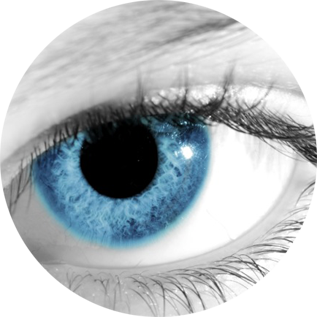Amblyopia
Lazy Eye
Lazy Eye is when one eye develops normal vision while the other does not.
Amblyopia, when one eye develops normal vision while the other does not, is a common condition occurring in 2 – 3% of the population. Usually, only one eye is affected. The eye with poor vision is called amblyopic.
The best time to detect and treat amblyopia is in infancy or early childhood. If there is a family history of eye conditions such as misaligned eyes, childhood cataracts, or serious eye disease, an ophthalmologist can check vision even earlier than age three. All children should have their vision checked by their pediatrician, family physician, or ophthalmologist at or before their fourth birthday.
The Development of Normal Vision
As newborn infants use their eyes during the first months of life, their vision improves rapidly. The visual system continues to change quickly and develop during childhood. Generally, after the age of 9, the visual system is fully developed and cannot be changed. Optimal vision does not develop if a child cannot use his or her eyes normally, and vision quality may even decrease.
Developing equal vision in both eyes is required for normal vision, and without normal vision in at least one eye, a person is considered visually impaired. If vision in one eye should be lost later in life from an accident or illness, it is essential that the other eye have normal vision.

Causes of Amblyopia
Any condition that affects normal use of the eyes can cause amblyopia, and In many cases, such conditions may be inherited. Children in a family with a history of amblyopia or misaligned eyes should be checked by an ophthalmologist early in life.
There are three common causes of amblyopia:
- Strabismus (misaligned eyes): With misaligned or crossed eyes, amblyopia occurs when the child uses only the better eye and essentially “turns off” the crossed eye to avoid double vision.
- Unequal focus (refractive error): Amblyopia can occur when one eye is out of focus because it is more nearsighted, farsighted or astigmatic than the other. The visual system “turns off” the unfocused eye which becomes amblyopic. The eyes can look normal but one eye has poor vision. A difficult type of amblyopia to detect, it requires careful measurement of vision in each eye.
- Cloudiness in normally clear eye tissues: Factors that prevent a clear image from being focused inside the eye, such as a cataract (clouding of the lens) can lead to childhood amblyopia. This is often the most severe form of amblyopia.
Diagnosing Amblyopia
Amblyopia is difficult for parents to diagnose because discerning that a child has one strong eye and one weak eye is not possible for anyone other than an experience ophthalmologist. There is often no way to tell that something is wrong unless the child has misaligned eyes or other visible problems.
The diagnosis depends on finding a difference in vision between the two eyes, a difficult evaluation. With infants, visual acuity is often checked by seeing how well the baby follows objects with one eye when the other eye is covered. If one eye is amblyopic and the good eye is covered, the baby may try to look around the patch or try to pull it off.
A careful examination of the interior of the eye is also required to determine if other eye diseases may be the cause of decreased vision, including:
- Cataracts
- Inflammations
- Tumors
- Other disorders of the inner eye
A diagnosis of poor vision in one eye does not necessarily mean that a child has amblyopia, and vision can often be improved by glasses.
Treating Amblyopia
While glasses may be prescribed to correct errors in focusing, that may not improve vision. Effective treatment may require using the weak eye to strengthen it, usually accomplished by patching or covering the strong eye, often for weeks of months. Part-time patching may be required over a period of years to maintain improvement. Another treatment involves blurring the vision in the good eye with special drops or lenses to force using and strengthening the weaker eye.
Such approaches are used before considering surgery, such as implanting an intraocular lens (IOL) to correct the problem. After surgery, glasses restore focusing, while patching improves vision.
Other factors involved in treating amblyopia include the severity of the case and the age of the child when treatment is initiated. If the condition is first discovered after early childhood, treatment may not be successful. Amblyopia caused by strabismus or unequal refractive errors may be successfully treated at an older age than amblyopia caused by cloudiness in eye tissue.
Detected and treated early, amblyopia can improve for most children, though part-time treatment may be required until the age of nine. After that age, amblyopia usually does not recur.

Strengthen the Weak Eye
While glasses or surgery can correct the cause of amblyopia, the ophthalmologist must also treat the amblyopia itself to prevent other potential problems. For example, the amblyopic eye may develop a permanent visual defect; depth perception may be lost; and if the good eye becomes vulnerable to disease or injury, poor vision for a lifetime may be the result.
Treating amblyopia becomes a joint effort between parents and child to understand and implement treatment instructions, and children may resist eye patching as they depend on the stronger eye to see clearly.
Parents play a crucial role in successful treatment. They must convince the amblyopic child to follow instructions and fully cooperate with recommended treatment if it is to be corrected.




